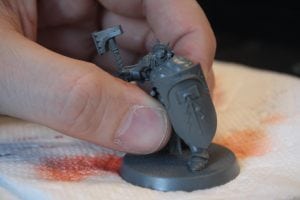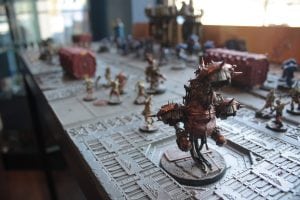At a first-floor suite inside Fairhaven’s Village Inn building, there awaits a world of fantastic characters, dramatic battles and mysterious realms. Welcome to the universe of “Warhammer,” the popular tabletop war game created in the 1980s by Nottingham, England-based Workshop Games. The company bills itself as the most successful hobby miniatures company in the world and currently has more than 130 stores in North America, about half of which have Warhammer branding.

In the Pacific Northwest, there are stores in Portland, Seattle, Tacoma, Olympia; Vancouver, BC and now, Bellingham. The Fairhaven location opened at the end of January to an excited local gaming community.
The “Warhammer” franchise has several game types, each revolving around a different storyline but with the same basic premise: hobbyists assemble and paint armies of plastic miniatures, then engage in battles through strategy and rolls of the dice, all in an effort to complete an overall game objective resulting in victory.
In addition to the customized painting of miniatures, players can also customize their game tables with paint and terrain features.
James Bell, Workshop Games’ North American marketing coordinator, says playing Warhammer often becomes a long-term and even lifelong hobby for its participants. Warhammer stores not only help recruit new people into the hobby, but also help people grow their interest and skill level once they’ve been at it a while.
The appeal of Warhammer extends widely, from young to old and male to female. “It’s an educational hobby, it’s a social hobby; it’s great for everyone in a family,” Bell says. “We have entire families that do this.”

Knowing nothing about the hobby, I step into the Bellingham store to indoctrinate myself. Inside, I am immediately greeted by Tom, the kind and helpful store manager. Surrounding him are shelves of products – game boards, painting accessories, character sets and game books.
Under the main storefront window are battle-ready game boards from Warhammer’s two primary offerings: Warhammer 40,000 – a science-fiction-based game set in a dystopian future – and Warhammer Age of Sigmar – a fantasy-based game set in a medieval, mythological world.
Shelving along one wall contains dozens of small paint containers with water-based colors like “Screaming Skull,” “Bugman’s Glow,” and “Niblet Green.”
First-time visitors to Warhammer receive a complimentary miniature to assemble and paint so without reservation, I dive in. Tom has me assemble a “Stormcast Eternal Liberator” – a roughly two-inch-tall, brutish-looking character clad in heavy armor and carrying a large shield and axe.

After freeing the pieces of my miniature from its plastic frame, Tom shows me how to use plastic glue to assemble it. The glue sets quickly and isn’t terribly sticky compared to traditional super glue, so it isn’t overly messy.
After that, my miniature needs priming. To move the process along, kind of like in a cooking show, Tom produces another miniature already primed in black. From there, I select my main color – an orange shade called “Ryza Rust.”
Using a small brush, I lightly coat my Liberator with paint, giving him a sort of bronzed look. After that, it’s time to highlight: mixing white and orange to create a lighter shade and add even more definition. Using only vertical strokes of the brush, I get carried away on the front side, leaving my character looking like he’s been hit with a bag of flour.
Once painting is complete, it’s time to name my warrior. While I imagine any character with the occupation “Eternal Liberator” should have an intense, dignified name like “Julius the Exhorter” or “Bob, Who Will Definitely Destroy You,” I choose the name Bartholomew, because on the field of battle, I figure nobody’s going to ask his name before chucking an axe at his head.

Once I’ve named my poorly-painted protagonist, it’s time to play Sigmar. It’s a game of eight realms and lots of blood, among other things. Frankly I’m lost on the storyline pretty quickly, but the gameplay itself becomes intuitive rather fast.
Each player’s turn consists of a movement phase, a shooting phase and a charge phase. A ruler is used to determine what a player can do with its miniatures. For example, if a player’s piece is six inches or less from an enemy miniature, it can attack.
On my first roll of the die, I come up with a five. A four or above means I get to attack. A die is cast for each miniature you can attack with. In a large battle, Tom says players can throw as many as 20 to 30 dice at one time. These dice are, as they need to be, rather small.
Choosing to attack a horde of opposing characters, I move my three Liberator miniatures into attack position and roll three dice. They come up snake eyes and a three. Tom takes his turn to swing back at me, but his dice also come up fruitless.

On my second roll, I get two sixes and a two, enough to kill two enemies because they each need two wounds to die. Different figures can take different damage amounts before dying, and also have different numbers of swings they can take at enemies.
We do several more attack phases before I’ve satisfied my mythological bloodlust for one evening, and thank Tom for his help.
In case you’re wondering, Tom estimates an average game of Warhammer takes about an hour or so, though game time is based on multiple factors and can stretch much longer.
Tom puts Bartholomew into a small box for me to take home, where he will likely be battling my cat as opposed to evil. Warhammer is clearly an engrossing hobby. If you have any interest in learning, keep in mind that classes and help are available for free at any Warhammer store.
Just try to be a better painter than me.
Sponsored










































